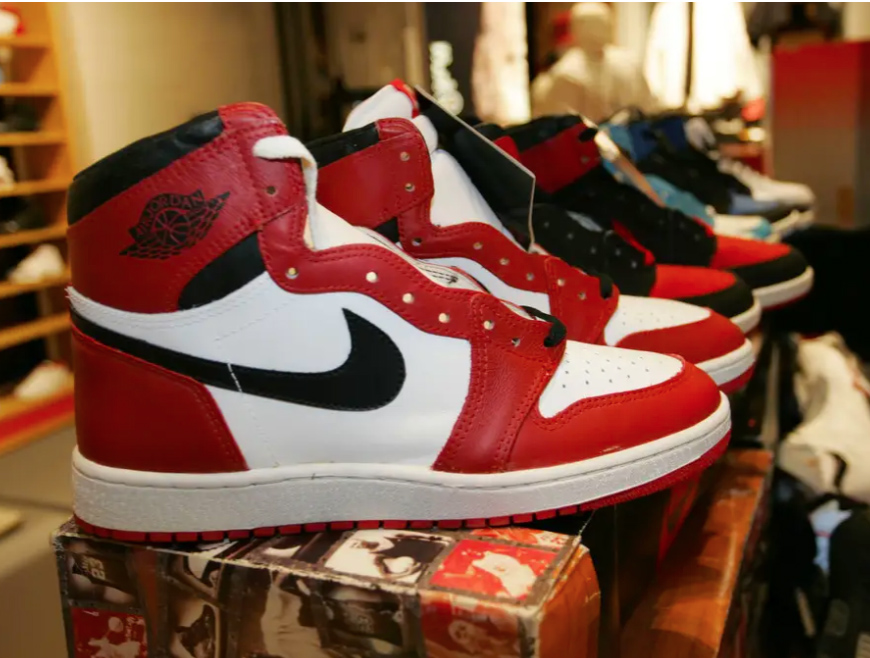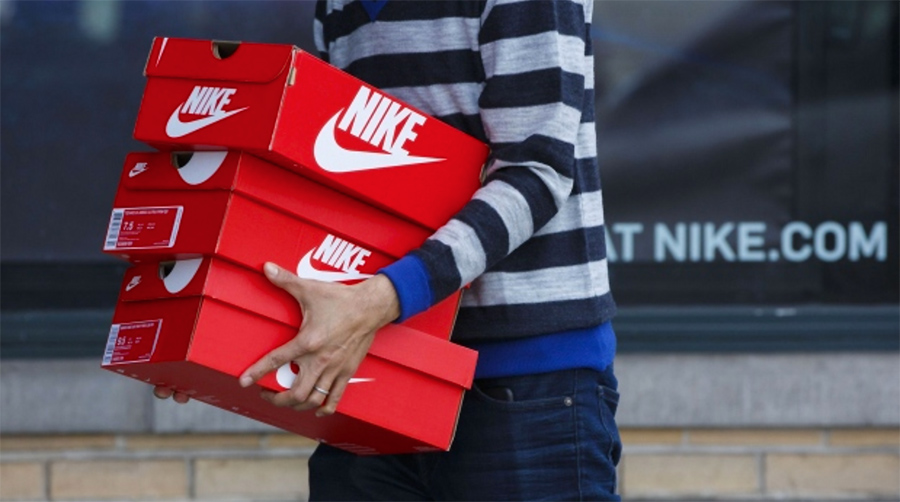By Thomas J. Ryan
<span style="color: #a1a1a1;">Nike said its move to stop selling to a number of major accounts marks an acceleration of its effort to clean up its distribution following the recent launch of its Consumer Direct Acceleration strategy.
As reported, Sam Poser, an analyst at Susquehanna International Group, in a note Monday said that proprietary checks by his team confirm that Nike will be closing nine wholesale accounts: City Blue, VIM, EbLens, Belk, Dillard’s, Fred Meyer, Bob’s Stores, Boscov’s, and Zappos.
Poser wrote, “We are unsure over what period of time the aforementioned retailers will be weaned from Nike product.”
In a statement sent to SGB Executive, Nike did not directly confirm the move but indicated that the company is stepping up efforts to tighten distribution.
The statement read, “Nike has a bold vision to create the marketplace of the future, one closely aligned with what consumers want and need. As part of our recently announced Consumer Direct Acceleration strategy, we are doubling down on our approach with Nike digital and our owned stores, as well as a smaller number of strategic partners who share our vision to create a consistent, connected and modern shopping experience.”
The reported account closures come as Nike has been in the process of gradually exiting wholesale accounts that do not adequately support Nike’s positioning in the marketplace. In 2017, Nike first announced plans to focus its organizational resources going forward on 40 key retail partners and its own consumer direct efforts while pulling back from “undifferentiated” channels of distribution.
<span style="color: #a1a1a1;">On June 25 during, its fourth-quarter conference call, Nike revealed a Consumer Direct Acceleration strategy designed to accelerate digital transformation; create a simpler consumer construct to better target Men’s, Women’s and Kids across categories; and unify technology investments.
On the call, John Donahoe, who joined Nike as president and CEO at the start of the year, described the Consumer Direct Acceleration as the “digitally empowered phase” of Nike’s Consumer Direct Offense strategy with the rollout accelerated due to COVID-19. He said, “Over the past few years we have shifted from a legacy wholesale distribution model to invest in a model that gives our consumers a more premium shopping experience, and this is a change that has catalyzed our digital growth as part of our true Consumer Direct Offense, and COVID-19 has shown that our strategy is sound.”
The move also comes as Nike’s online growth business has accelerated over the past few years and took another step forward during the stay-at-home order amid the pandemic. In the fourth quarter ended May 31, online sales rose 79 percent on a currency-neutral basis. On the call, Nike officials said they expected to reach 30 percent digital penetration (owned and partnered) in fiscal 2021 versus a previous goal of FY23.
Director-to-consumer (DTC) sales have also expanded as Nike’s store base has grown in addition to its online growth. Overall, DTC accounted for 34.8 percent of Nike Brand revenue in the year ended May 31, 2020, up from 31.6 percent a year ago. In fiscal 2015, DTC accounted for only 23.1 percent of Nike Brand sales.
 According to the Susquehanna report, the nine retailers that Nike has announced it would end distribution with include:
According to the Susquehanna report, the nine retailers that Nike has announced it would end distribution with include:
- City Blue, a Philadelphia-based urban fashion chain with 20 stores in Pennsylvania, New Jersey, Ohio, and Deleware;
- VIM, a Brooklyn-based chain with 31 stores in New York and New Jersey;
- EbLens, a Torrington, CT-based retailer with 48 locations in New England and New York markets;
- Belk, the Charlotte, NC-based department store operator with 300 stores primarily in the Southeast;
- Dillard’s, the Little Rock, AR-department store operator with 251 Dillard’s stores and 31 clearance centers in 29 states concentrated in the Southeast, Central and Southwestern U.S.;
- Fred Meyer, a Portland, OR-based superstore with 130 locations in Oregon, Washington, Idaho, and Alaska. Kroger, the second-largest grocer after Walmart, acquired the business in 1998 but the stores are still branded Fred Meyer;
- Bob’s Stores, the Meriden, CT-based family apparel chain with 24 stores in the Northeast. Frasers Group, the U.K.-based parent of Sports Direct, acquired Bob’s out of bankruptcy proceedings in 2017;
- Boscov’s, a Reading, PA-based department store with 50 locations in Pennsylvania, New York, New Jersey, Delaware, Maryland, Ohio, Connecticut, and Rhode Island; and
- Zappos, the Las Vegas-online footwear e-tailer acquired by Amazon in 2009.
In analyzing the move, Poser wrote that the closing of nine accounts “is positive for Nike as it takes control of more of its own destiny.”
Among retailers, Poser said that based on the locations of the accounts to be closed as well as brand exposure, Dick’s Sporting Goods, Shoe Carnival and Hibbett Sports “will likely be the greatest beneficiaries of Nike’s decision.”
<span style="color: #a1a1a1;">In 2019, Nike Inc., including Converse as well as the Nike brand, accounted for 21 percent of merchandise purchases for Dick’s, 70 percent for Hibbett, and 30 percent for Shoe Carnival. Shoe Carnival has long put a greater emphasis on athletic styles among off-price footwear sellers.
Among other publicly-held retailers, Poser said the decision “is good news, or provides a potential break,” for Famous Footwear and DSW, owned by Designer Brands. DSW has been aggressively expanding into athletics in recent years while Famous Footwear has seen strength in the athletics category.
Poser added that less distribution from these accounts helps Foot Locker “to some degree.” Across Foot Locker’s banners, 71 percent of all merchandise purchased in 2019 came from Nike. Foot Locker shares a similar concentration of Nike products as Hibbett, but its stores are more heavily concentrated in metropolitan centers.
News that Nike planned to pare down its wholesale account base has led to speculation over the last few years about which accounts would make, and not make, the cut.
Among major accounts that Nike is largely expected to continue to work with are those that Nike officials have highlighted on quarterly conference calls over the last three years. In many cases, the chains are called out due to collaboration supporting Nike storytelling/customer engagement.
In the U.S., cited retailers include Dick’s, Foot Locker and Nordstrom. In Europe, Zalando, Europe’s largest online fashion retailer and platform, as well as JD Sports, the U.K.’s leading sports and footwear brand that’s expanding across Europe, have both been called out.
JD Sports, which is Nike’s second-biggest global customer behind Foot Locker, acquired The Finish Line chain in 2018 and is working on reviving the sneaker chain while launching the flagship JD Sports as a separate banner in the U.S. In China, Nike has called its collaboration efforts with Tmall while also noting the brand’s success with Topsports and Pou Sheng.
Among those seen as not making the cut is Amazon, the world’s largest online retailer.
In 2017, Nike had started a pilot selling a limited amount of Nike branded merchandise on Amazon. Many observers saw the partnership as a way for Nike to reduce counterfeit selling and unauthorized sellers below MAP (minimum advertised price) policies while benefiting from Amazon’s volume potential. Yet many felt the move contradicted Nike’s intention to avoid selling at overly price-driven retailers. In November 2019, Nike said it would stop selling its sneakers and apparel directly on Amazon’s website.
“As part of Nike’s focus on elevating consumer experiences through more direct, personal relationships, we have made the decision to complete our current pilot with Amazon Retail,” Nike said in a statement at the time. “We will continue to invest in strong, distinctive partnerships for Nike with other retailers and platforms to seamlessly serve our consumers globally.”
Also on the outs is Sports Direct which, in October 2019, called for a European-wide investigation into the dominance of Nike as well as Adidas in the sportswear market.
Sports Direct wrote in its statement at the time, “The sports industry has long been dominated by the ‘must-have’ brands such as Adidas. These ‘must-have’ brands hold an extremely strong bargaining position vis-à-vis the retailers within their supply networks, and use their market power to implement market-wide practices aimed at controlling the supply and, ultimately, the pricing of their products.”
Sports Direct has been investing in upgrading efforts in part to support access to premium brands.
Sports Direct’s call for an inquiry was revealed in an article in The Sunday Times entitled, “Nike’s Killer Blow For Small Stores.” The article indicated that Nike had sent a letter to “dozens of independent retailers” in the UK indicating they would no longer have access to Nike products by 2021.
However, in a note from August 19, Susquehanna’s Poser said that the ongoing consolidation of Nike’s wholesale partner base did not appear to be based on size.
Poser wrote, “Our checks reveal that smaller, more boutique tier-zero accounts are now receiving larger allocations of the latest launches. Thus, while the size is likely a factor in NKE’s decision to keep, or eliminate a wholesale partner, we believe how well the wholesale partner enhances the Nike brand will prove to be the No. 1 guiding factor. While it is difficult to parse out the winners and losers, one thing is clear: those wholesale partners that elevate the Nike brand to the level NKE expects will be ‘the chosen ones.'”
Photos coutesy Nike
















